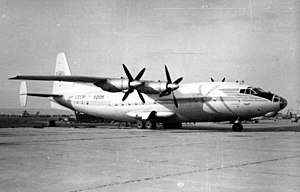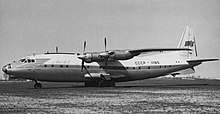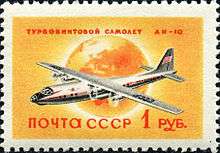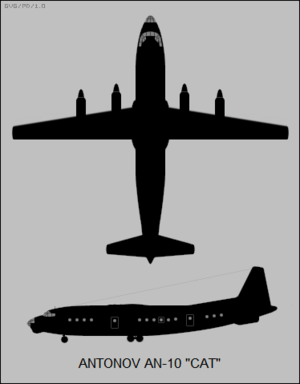Antonov An-10
The Antonov An-10 (Russian: Антонов Ан-10; NATO reporting name: Cat) is a four-engined turboprop passenger transport aircraft designed in the Soviet Union.[1]
| An-10 | |
|---|---|
 | |
| Role | Airliner |
| Manufacturer | Antonov |
| Designer | N. S. Trunchenkov & V. N. Ghel'prin[1] |
| First flight | 7 March 1957[1] |
| Introduction | 1959 |
| Retired | 1974 |
| Status | Retired |
| Primary user | Aeroflot |
| Number built | 104[1] |
| Developed into | Antonov An-12 |
Design and development


Development of a four-engined airliner intended for use on routes from 500 to 2000 kilometers (310 to 1,262 miles) began at the end of 1955. Inspired by the Izdeliye N (Izdeliye – article or product) passenger version of the Antonov An-8, the Antonov design bureau developed the Izdeliye U ("U" for "Universal"), a four-engined aircraft with a similar layout to the An-8, but with increased dimensions and a circular-section pressurised fuselage.[1] Early in the design process the choice of engines was between the Kuznetsov NK-4 and the Ivchenko AI-20, and despite superior performance the Kuznetsov NK-4 was eliminated and the Ivchenko AI-20 selected, partly due to the Central Committee of the Communist Party of Ukraine which wanted as much as possible produced in Ukraine, where the Ivchenko factory was.[1]
The first prototype flew on 7 March 1957, revealing poor directional stability which led to a taller vertical fin, and later to hexagonal auxiliary fins at the tips of the tailplane. Entering production at Zavod (factory) No.64, Voronezh in 1957, the initial three aircraft were delivered with Kuznetsov NK-4 engines, due to non-availability of the Ivchenko AI-20 engines. From 1958, production aircraft were delivered with the Ivchenko AI-20A engines which boasted a longer service life and comparable performance compared to the Kuznetsov engines.[1] The new aircraft was displayed to the public for the first time in July 1957; the design was approved for mass production after testing was completed in June 1959.[1] Aeroflot began operations with the An-10 from 22 July 1959 on the Moscow – Simferopol route.
Configured with 85 seats, the cabin was spacious and well-appointed with comfortable seats widely spaced, giving plenty of legroom, but due to the low cabin floor and wide diameter, there was much unusable space which limited baggage and cargo volume. The inefficient use of cabin volume contributed greatly to the low payload/TOW ratio which was much lower than that of the contemporary Ilyushin Il-18, but which was still higher than the Tupolev Tu-104. A later production version, the An-10A, addressed some of the efficiency concerns by increasing the number of seats from 85 to 89 and 100 (in the two versions of the An-10A), then to 117–118 and finally 132 through reducing seat pitch and changing the cabin layout.[1] Powered by Ivchenko AI-20K engines the An-10A demonstrated superior performance and an increased maximum payload of 14.5 Tonnes (31,970 lb). The auxiliary endplate fins eventually gave way to improved splayed ventral fins under the rear fuselage. The directional stability was now acceptable and the new ventral fins also improved longitudinal stability at high g and on landing approach, as well as delaying the onset of Mach buffet to M0.702. Due to being sited in an area of flow separation, the new ventral fins also caused unpleasant vibrations. Following results of flight tests and at least two fatal crashes, an effective tailplane deicing system was retrofitted to all remaining aircraft.[1]
Operational history
.jpg)
A total of 104 aircraft were built, including the prototype and static test airframes, entering service with the Ukrainian Civil Aviation Directorate of Aeroflot from 27 April 1959,[1] proving popular due to large cargo volume (when fitted with reduced seating) and excellent field performance, making the aircraft suitable for use on small undeveloped airfields. The Antonov Bureau simultaneously developed and produced the Antonov An-8 medium military transport, the An-10 civil airliner and military paratroop transport, as well as the Antonov An-12 military cargo transport.[1]
On 16 November 1959 CCCP-11167 crashed on final approach near Lviv due to icing.[2]
On 22 April 1962 an An-10A piloted by A. Mitronin achieved a world record 500 km closed loop speed record averaging 730.6 kilometres per hour (454.0 mph).[1]
On 26 February 1960, at Lviv Danylo Halytskyi International Airport, CCCP-11180 crashed due to reduced longitudinal stability and control authority caused by icing of the tailplane.[1]
Military use of the An-10 was fairly extensive with 45 An-10TS built for the VTA, 16 flown exclusively by military units and the remaining 38 loaned to the Ministry of Civil Aviation, as well as the flyable aircraft remaining after withdrawal from Aeroflot service.[1]
On 18 May 1972, while descending to Kharkiv International Airport an An-10 crashed, killing eight crew and 113 passengers. An investigation revealed fatigue cracking of the wing centre section stringers on many of the remaining aircraft. Following this accident, Aeroflot ceased operating the An-10.[3]
After withdrawal from Aeroflot service on 27 August 1972, 25 An-10A aircraft which were in good condition were transferred to the VVS (Soviet Air Force) and other MAP (Ministry of Aircraft Production) units.[1] These remaining An-10As were retired by 1974.
A few examples have been preserved as exhibits in museums, and several have been converted into children's theatres (at Kiev, Samara and Novocherkassk).
Variants
- Izdeliye U – The in-house designation of the four-engined passenger aircraft derived from the Izdeliye N An-8 project.[1]
- An-10 – The designation of the prototype and initial production versions fitted with Kuznetsov NK-4 or Ivchenko Ai-20A engines.[1]
- An-10A – Production aircraft from December 1959 with increased seating, decreased empty weight/increased payload and Ivchenko AI-20K engines.[1]
- An-10AS – several aircraft modified for small package cargo transport with no seats.[1]
- An-10TS – (Transport/Sanitarny – transport/ambulance) 45 Aircraft ordered for the VTA (Voyenno-Transportnaya Aviatsiya – transport air arm), with 38 loaned to the Ministry of Civil Aviation.[1]
- An-10KP – (Komandny Punkt – command post) A single aircraft (CCCP-11854) modified as an airborne command post for use at Sperenberg Airfield, near Berlin in the DDR.[1]
Accidents and incidents
Over its life, the An-10 experienced 14 accidents,[4] with 373 fatalities. The An-10 carried more than 35 million passengers and 1.2 million tons of cargo.
| Date | Registration | Location (all in the Soviet Union) | Casualties | Brief description |
|---|---|---|---|---|
| 29 April 1958 | CCCP-L7256 | Voronezh | 1/5 | crashed during test flight |
| 16 Nov 1959 | CCCP-11167 | Lviv | 40/40 | fell into dive on landing due to icing on wings |
| 26 Feb 1960 | CCCP-11180 | Lviv | 32/33 | fell into dive on landing due to icing on wings |
| 27 January 1962 | CCCP-11148 | Ulyanovsk | 13/14 | crashed on takeoff due to reversing propeller |
| 28 July 1962 | CCCP-11186 | Sochi | 81/81 | collision into mountain due to controller error |
| 2 August 1963 | CCCP-11193 | Syktyvkar | 7/7 | ingress of ice into engines during training flight |
| 8 August 1968 | CCCP-11172 | Mirny | 0/no data | ran off runway, struck a vehicle |
| 12 October 1969 | CCCP-11169 | Mirny | 0/no data | landed short of runway |
| 15 May 1970 | CCCP-11149 | Kishinev | 11/11 | loss of control during training flight during simulated missed approach on two engines |
| 8 August 1970 | CCCP-11188 | Kishinev | 1/114 | emergency landing in field due to in-flight fire |
| 31 March 1971 | CCCP-11145 | Voroshilovgrad | 65/65 | crashed on approach due to wing separation |
| 12 October 1971 | CCCP-11137 | Kishinev | no data | rough landing |
| Feb 1972 | CCCP-11142 | Rostov | no data | burned out during maintenance |
| 18 May 1972 | CCCP-11215 | Kharkiv | 122/122 | both wings fell off during landing, metal fatigue |
Specifications (An-10A)

Data from Soviet Transport Aircraft since 1945[5], Jane's all the World's Aircraft 1970–71[6]
General characteristics
- Crew: 4 flight crew +cabin crew
- Capacity: 100 or 130 pax / 14,500 kg (32,000 lb)
- Length: 34 m (111 ft 7 in)
- Wingspan: 38 m (124 ft 8 in)
- Height: 9.83 m (32 ft 3 in)
- Wing area: 120 m2 (1,300 sq ft)
- Volume: 222 m3 (7,800 cu ft) cabin volume
- Underfloor hold volume: 32 m3 (1,100 cu ft)
- Max takeoff weight: 55,100 kg (121,475 lb)
- Fuel capacity: 13,000 l (3,400 US gal; 2,900 imp gal) (10,250 kg (22,600 lb))
- Powerplant: 4 × Ivchenko AI-20K turboprop engines, 3,000 kW (4,000 hp) each (equivalent)
- Propellers: 4-bladed AV-68 reversible-pitch constant-speed propellers, 4.5 m (14 ft 9 in) diameter
Performance
- Maximum speed: 715 km/h (444 mph, 386 kn)
- Cruise speed: 680 km/h (420 mph, 370 kn) maximum at 10,000 m (33,000 ft)
- Economical cruise speed: 630 km/h (390 mph; 340 kn) at 10,000 m (33,000 ft)
- Take-off speed: 190–210 km/h (120–130 mph; 100–110 kn)
- Range: 1,200 km (750 mi, 650 nmi) with max payload + 60 minutes reserve fuel
- 4,075 km (2,532 mi) with max fuel 8,440 kg (18,610 lb) payload and no reserves
- Service ceiling: 10,200 m (33,500 ft)
- Wing loading: 430 kg/m2 (88 lb/sq ft)
- Power/mass: 4.4 kg/kW (7.2 lb/hp)
- Landing run: 500–650 m (1,640–2,130 ft) with reverse pitch
See also
Related development
Aircraft of comparable role, configuration and era
Related lists
- List of airliners
References
- Gordon, Yefim; Komissarov, Dmitry (2007). Antonov An-12 : the Soviet Hercules. Hinkley: Midland. ISBN 978-1-85780-255-9.
- "Monday 16 November 1959". aviation-safety.net. Aviation Safety Network. Retrieved 21 July 2019.
- Gero, David (1996). Aviation Disasters Second Edition. Patrick Stephens Limited. p. 105.
- Ratner, Harro. "Aviation Safety Network > ASN Aviation Safety Database > Aircraft type index > Antonov An-10 > Antonov An-10 Statistics". aviation-safety.net. Retrieved 30 March 2019.
- Stroud, John (1968). Soviet transport aircraft since 1945. London: Putnam. p. 63. ISBN 0-370-00126-5.
- Taylor, John W.R., ed. (1970). Jane's all the World's Aircraft 1970–71. London: Sampson Low, Marston & Company. p. 480. ISBN 978-0-354-00067-3.
Further reading
- Gunston, Bill (1995). The Osprey Encyclopedia of Russian Aircraft 1875–1995. London: Osprey. pp. 23–24. ISBN 1-85532-405-9.
External links
| Wikimedia Commons has media related to Antonov An-10. |
- "AirDisaster.Com Accident Database » AirDisaster.Com » Accident Database » Aircraft Crash Details » Antonov AN-10". airdisaster.com. Archived from the original on 3 September 2004. Retrieved 30 March 2019.